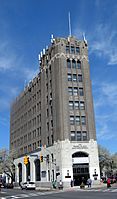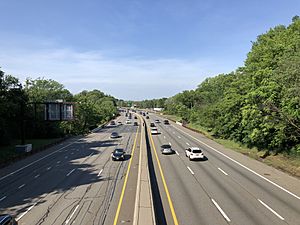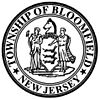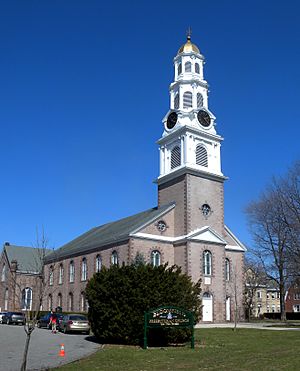Bloomfield, New Jersey facts for kids
Quick facts for kids
Bloomfield, New Jersey
|
||
|---|---|---|
|
Township
|
||

Frank M. Leo Associates Building in downtown Bloomfield
|
||
|
||
| Country | ||
| State | ||
| County | Essex | |
| Incorporated | March 23, 1812 | |
| Named for | Joseph Bloomfield | |
| Government | ||
| • Type | Special charter | |
| • Body | Township Council | |
| Area | ||
| • Total | 5.36 sq mi (13.88 km2) | |
| • Land | 5.34 sq mi (13.82 km2) | |
| • Water | 0.02 sq mi (0.06 km2) 0.45% | |
| Area rank | 268th of 565 in state 7th of 22 in county |
|
| Elevation | 174 ft (53 m) | |
| Population
(2020)
|
||
| • Total | 53,105 | |
| • Estimate
(2023)
|
53,702 | |
| • Rank | 36th of 565 in state 4th of 22 in county |
|
| • Density | 9,950.3/sq mi (3,841.8/km2) | |
| • Density rank | 38th of 565 in state 6th of 22 in county |
|
| Time zone | UTC−05:00 (Eastern (EST)) | |
| • Summer (DST) | UTC−04:00 (Eastern (EDT)) | |
| ZIP Code |
07003
|
|
| Area code(s) | 862/973 | |
| FIPS code | 3401306260 | |
| GNIS feature ID | 1729714 | |
Bloomfield is a township in Essex County, New Jersey. It's a town located close to Newark. In 2020, about 53,105 people lived there. Bloomfield is home to the Bloomfield Green Historic District, which became a special historic place in 1978.
Contents
History of Bloomfield
Early Settlers and European Arrival
The first people to live in the Bloomfield area were the Lenape Native Americans. Later, in the late 1600s, English settlers from Newark began to move into the area. Over time, Dutch families also bought land and settled here. This led to different neighborhoods with English and Dutch speakers.
Bloomfield During the Revolutionary War
Many people from Bloomfield fought in the American Revolutionary War. While no major battles happened here, the area was part of the Continental Army's path after the Battle of Long Island. It's believed that General George Washington himself visited some homes in Bloomfield. The area known as The Green was set aside for training local soldiers.
How Bloomfield Got Its Name
The Presbyterian Church in Bloomfield was formed in 1794. It was named after Joseph Bloomfield, who was a general leading New Jersey troops at the time. He later became the governor of New Jersey. On March 23, 1812, Bloomfield officially became a township.
Growth and Changes Over Time
When Bloomfield first became a township, it was much larger. Over the years, several other towns like Belleville, Montclair, and Glen Ridge were formed from parts of Bloomfield.
In its early years, the northern part of Bloomfield had many farms, while the southern part became more industrial. Factories like the Oakes woollen mill, which supplied the Union Army, became very important. The Morris Canal also passed through Bloomfield, helping with transportation.
In the 20th century, big companies like GE, Westinghouse, and Schering built large facilities here. The Charms Candy Company also started in Bloomfield. After World War I, many farms became neighborhoods, and the town grew a lot until the 1950s. During World War II, Bloomfield's factories and farms helped the war effort, with many women working to support the country.
Later in the 20th century, many factories closed due to new rules and competition. This, along with the building of the Garden State Parkway, changed the town. In recent years, Bloomfield has been focusing on becoming more of a residential town, with new homes and services.
Geography and Location
Bloomfield covers about 5.36 square miles (13.9 km2) (13.88 km2) of land. A very small part is water.
Neighborhoods in Bloomfield
Bloomfield has several neighborhoods. Some of these are called census-designated places (CDPs), which means they are recognized for counting purposes by the U.S. Census Bureau. These include:
- Silver Lake (shared with Belleville)
- Brookdale
- Watsessing
- Ampere North
Bloomfield is part of the larger New York metropolitan area. It shares borders with several other towns in Essex County, including Belleville, East Orange, Glen Ridge, Montclair, Newark, and Nutley. It also borders Clifton in Passaic County.
Population and People
| Historical population | |||
|---|---|---|---|
| Census | Pop. | %± | |
| 1820 | 3,085 | — | |
| 1830 | 4,309 | 39.7% | |
| 1840 | 2,528 | * | −41.3% |
| 1850 | 3,385 | 33.9% | |
| 1860 | 4,790 | 41.5% | |
| 1870 | 4,580 | * | −4.4% |
| 1880 | 5,748 | 25.5% | |
| 1890 | 7,708 | 34.1% | |
| 1900 | 9,668 | * | 25.4% |
| 1910 | 15,070 | 55.9% | |
| 1920 | 22,019 | 46.1% | |
| 1930 | 38,077 | 72.9% | |
| 1940 | 41,623 | 9.3% | |
| 1950 | 49,307 | 18.5% | |
| 1960 | 51,867 | 5.2% | |
| 1970 | 52,029 | 0.3% | |
| 1980 | 47,792 | −8.1% | |
| 1990 | 45,061 | −5.7% | |
| 2000 | 47,683 | 5.8% | |
| 2010 | 47,315 | −0.8% | |
| 2020 | 53,105 | 12.2% | |
| 2023 (est.) | 53,702 | 13.5% | |
| Population sources: 1820–1920 1820–1910 1840 1850–1870 1850 1870 1870–1890 1880–1890 1890–1910 1900–1930 1940–2000 2000 2010 2020 |
|||
In 2014, the cost of living in Bloomfield was about 20% higher than the average for the United States.
Population in 2020
The 2020 United States census showed that Bloomfield had a population of 53,105 people. This was a good increase from the 2010 census.
The town is very diverse, with people from many different backgrounds. The table below shows the racial and ethnic makeup of Bloomfield:
| Race / Ethnicity (NH = Non-Hispanic) | Pop 1990 | Pop 2000 | Pop 2010 | Pop 2020 | % 1990 | % 2000 | % 2010 | % 2020 |
|---|---|---|---|---|---|---|---|---|
| White alone (NH) | 38,578 | 30,036 | 22,291 | 19,668 | 85.61% | 62.99% | 47.06% | 37.02% |
| Black or African American alone (NH) | 1,873 | 5,332 | 8,092 | 9,941 | 4.16% | 11.18% | 17.12% | 18.72% |
| Native American or Alaska Native alone (NH) | 40 | 51 | 102 | 84 | 0.09% | 0.11% | 0.22% | 0.16% |
| Asian alone (NH) | 2,207 | 3,980 | 3,846 | 4,495 | 4.90% | 8.35% | 8.13% | 8.47% |
| Pacific Islander alone (NH) | N/A | 30 | 14 | 4 | N/A | 0.06% | 0.03% | 0.01% |
| Some Other Race alone (NH) | 52 | 296 | 407 | 713 | 0.12% | 0.62% | 0.86% | 1.34% |
| Mixed Race or Multi-Racial (NH) | N/A | 1,057 | 957 | 2,003 | N/A | 2.22% | 2.02% | 3.77% |
| Hispanic or Latino (any race) | 2,311 | 6,901 | 11,606 | 16,197 | 5.13% | 14.47% | 24.55% | 30.52% |
| Total | 45,061 | 47,683 | 47,315 | 53,105 | 100.00% | 100.00% | 100.00% | 100.00% |
Parks and Recreation in Bloomfield
Bloomfield has several great parks for outdoor activities.
- Brookdale Park is a large park that covers over 121 acres (49 ha). Most of it is in Bloomfield, and it's the third-largest park in Essex County.
- Watsessing Park is another big park, covering about 69.67 acres (28.19 ha). It's shared with East Orange and has parts of the Second River flowing through it. It's the fourth-largest park in the county.
Both Brookdale and Watsessing Parks are managed by the Essex County Department of Parks, Recreation, and Cultural Affairs. Besides these, the Bloomfield Parks and Recreation Department manages eight other parks in the town.
Education in Bloomfield
Public Schools
The Bloomfield Public Schools serve students from pre-kindergarten all the way through twelfth grade. The district has 11 schools, including:
- Early Childhood Center at Forest Glen (PreK)
- Berkeley Elementary School (K-6)
- Brookdale Elementary School (K-6)
- Carteret Elementary School (K-6)
- Demarest Elementary School (K-6)
- Fairview Elementary School (PreK-6)
- Franklin Elementary School (K-6)
- Oak View Elementary School (PreK-6)
- Watsessing Elementary School (K-6)
- Bloomfield Middle School (7-8)
- Bloomfield High School / Bridges Academy (9-12)
There is also Bloomfield Tech High School, which is a special public high school for students across Essex County. It offers job-focused and academic classes.
Catholic Schools
Saint Thomas the Apostle Parish School is a Catholic school in Bloomfield that serves students from kindergarten to 8th grade.
Colleges and Universities
Bloomfield College is a liberal arts college located in downtown Bloomfield. It was founded in 1868 and has about 2,000 students.
Transportation in Bloomfield
Roads and Highways

Bloomfield has many miles of roads. The main highway that goes through Bloomfield is the Garden State Parkway. This is the longest road in New Jersey. It has several exits in Bloomfield, and the Essex toll plaza is also located here. There are also rest stops on the Parkway in Bloomfield.
Other important county roads like County Road 506 and 509 also serve the town.
Train Service
Bloomfield has two train stations on the NJ Transit Montclair-Boonton Line:
- The Bloomfield train station is in the downtown area.
- The Watsessing Avenue station is located underground.
These trains can take you to Hoboken Terminal or to Penn Station in Midtown Manhattan.
Light Rail Service
The Grove Street station is part of the Newark Light Rail system. It connects Bloomfield to Newark Penn Station. This light rail line was extended to Bloomfield in 2002.
Bus Service
NJ Transit offers many bus routes in Bloomfield. You can take buses to and from Newark and also to the Port Authority Bus Terminal in New York City. There's even a Go Bus route that goes from the Bloomfield Train Station to Newark Liberty International Airport.
Airports
Bloomfield is conveniently located near two major airports:
- Newark Liberty International Airport is about 7.5 miles (12.1 km) away.
- LaGuardia Airport in Queens, New York, is about 28.8 miles (46.3 km) away.
Places to Visit
- Glendale Cemetery is a historic cemetery.
- Holsten's Brookdale Confectionery is a famous ice cream parlor. It was used as a filming location for the final scene of the TV show The Sopranos.
- The Oakes Estate is a beautiful historic home built in 1895. It was added to the National Register of Historic Places in 1981.
Notable Events
In 1942, the Westinghouse Lamp Plant in Bloomfield played a big role in the Manhattan Project. They produced most of the uranium metal used in the Chicago Pile-1, which was the world's first self-sustaining nuclear chain reaction. This was an important step in creating the first atomic bomb.
Famous People from Bloomfield
Many interesting people have been born in, lived in, or are connected to Bloomfield. Here are a few:
- Alaa Abdelnaby (born 1968), former NBA basketball player
- James Avati (1912–2005), illustrator and paperback cover artist
- Fallah Bahh (born 1985 as Francis Flores), professional wrestler
- Caleb Cook Baldwin (1820–1911), one of the first Presbyterian missionaries to China
- Robert Birmelin (born 1933), painter and printmaker
- Seth Bingham (1882–1972), organist and composer
- William D. Bishop (1827–1904), former U.S. Representative
- Elizabeth Blackwell (1821–1910), the first woman doctor
- Hank Borowy (1916–2004), Major League Baseball All-Star pitcher
- Randolph Bourne (1886–1918), writer and opponent of World War I
- William Batchelder Bradbury (1816–1868), composer of "Jesus Loves Me"
- Doug Brien (born 1970), former NFL placekicker
- Kevin Burkhardt (born 1974), sportscaster for NFL on FOX and New York Mets
- Thomas Cadmus (1736–1821), Revolutionary War officer and community leader
- Marco Capozzoli (born 1988), Arena Football League placekicker
- Lou Carter (1918–2005), jazz pianist and songwriter
- William F. Conger (1844–1918), businessman and politician
- Rajie Cook (1930–2021), graphic designer and artist
- Marion Crecco (1930–2015), former New Jersey General Assembly member
- Tom Cudworth (born 1964), screenwriter
- Peter David (born 1956), science fiction and fantasy author
- Frank Howard Dodd (1844–1916), publisher
- Charles Warren Eaton (1857–1937), artist known for his landscapes
- Todd Edwards (born 1972), house music and UK Garage producer
- Bud Ellor (1905–1932), professional football player
- Bento Estrela (born 2006), professional footballer for New York Red Bulls
- Alex Ferguson (1897–1976), Major League Baseball pitcher
- Tom Fleming (1951–2017), long-distance runner and two-time New York City Marathon winner
- Connie Francis (born 1937), famous singer
- Bill Geyer (1919–2004), former Chicago Bears halfback
- Johnny Gibson (1905–2006), Olympic runner
- Michael Giuliano (1915–1976), politician who served in the New Jersey Senate
- Roger Lee Hall (born 1942), composer and musicologist
- Ernie Hambacher (1906–1990), NFL fullback
- Merton Hanks (born 1968), former NFL safety
- Larry Hesterfer (1878–1943), MLB pitcher
- Benjamin Holman (1930–2007), pioneering black journalist
- Jim Kelly (1884–1961), MLB outfielder
- Charles Kinsey (1773–1849), U.S. Representative
- Michael Knapp (born 2000), professional soccer player
- Mike Kochel (1916–1994), NFL player for the Chicago Cardinals
- Andy Kostecka (1921–2007), professional basketball player
- Ted Leo (born 1970), punk rock singer and guitarist
- Bob Ley (born 1955), ESPN sportscaster
- Michael Maslin, cartoonist for The New Yorker
- Keven McDonald (born 1956), college basketball player
- Edward Page Mitchell (1852–1927), writer for The Sun
- R. Stevie Moore (born 1952), lo-fi music singer/songwriter
- Charles A. Morris (1853–1914), engineer and inventor
- Mike Olla (born 1994), professional soccer forward
- Clayton Parros (born 1990), track and field sprinter
- Robert A. Pascal (1934–2021), former county executive
- Marion Post Wolcott (1910–1990), photographer for the Farm Security Administration
- Charlie Puleo (born 1955), retired Major League Baseball pitcher
- Philip Reilly (born 1952), fencer who competed in the Olympics
- Andrew J. Robinson (c. 1843–1922), builder
- Jack Robinson (1921–2000), professional baseball pitcher
- Don Savage (1919–1961), Major League Baseball player
- Mark Sceurman, co-creator and publisher of Weird NJ magazine
- Anish Shroff (born 1982), ESPN sportscaster
- Thomas S. Smith (1917–2002), politician
- Kristjan Sokoli (born 1991), American football defensive end
- Robert Stempel (1933–2011), former Chairman and CEO of General Motors
- Frank Tripucka (1927–2013), pro football Denver Broncos' quarterback
- Kelly Tripucka (born 1959), pro basketball player
- Todd Tripucka (born 1954), former basketball player
- Marlene VerPlanck (1933–2018), jazz and pop vocalist
- Michael Venezia, former mayor of Bloomfield
- E. Duke Vincent (born 1932 as Edward Ventimiglia), television producer
- Alexander Wilson (1766–1813), the Father of American Ornithology
- Dick Zimmer (born 1944), former U.S. Representative
See also
 In Spanish: Municipio de Bloomfield (Nueva Jersey) para niños
In Spanish: Municipio de Bloomfield (Nueva Jersey) para niños






